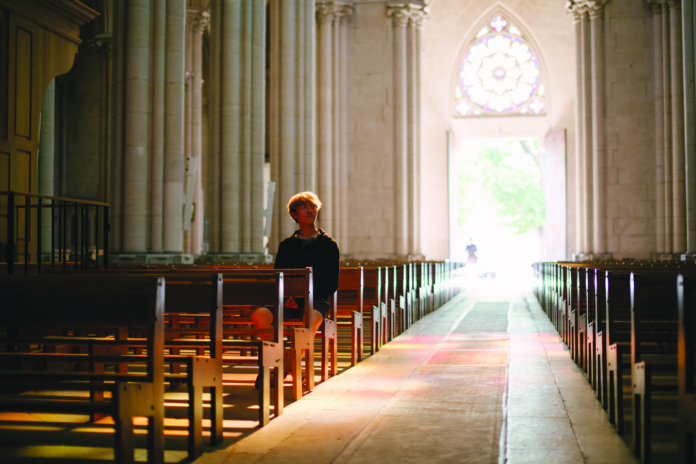There is an unprecedented crisis in our cities, yet most are not aware of it. It does not affect residents nor shoppers in our tony neighborhoods. In working-class neighborhoods some see it as a concern, but they are a minority. What is this crisis? In dioceses across the country, including Boston, Cleveland, Chicago, and New York, we have faced a historic number of church closings. The reasons are due to a lack: of funds, of parishioners, or of priests. Small dioceses are also suffering from this crisis, and they are trying to be good stewards of their finances.
But why is closing church buildings a big issue? Because they are holy places, dedicated to God and His saints, set apart for worship and the reception of the sacraments, paid for by the faithful, and honored as repositories of sacred and devotional art. What the Modernists said about the ethnic churches in many of our cities and towns is often true: they were often not well built and not that beautiful. They were put up quickly on low budgets by poor, uneducated immigrants. Yet for many people these buildings seem like masterpieces in comparison to the worship spaces that we—wealthy, educated, and professional—have built over the past fifty years.
One solution is to sell the church. Not to a Protestant congregation, which usually has limited funds, but to a developer who could retrofit it into some secular use, whether as condominiums, office space, or a community hall. Well-known examples of this are the renovations of the former Los Angeles cathedral, Saint Vibiana, into a wedding and corporate event center, and of Saint John the Baptist Church in Pittsburgh into a brew pub. Often when a sale is proposed, the overly pious are assured that all of the major artistic pieces will be removed, meaning altars, stained glass, and statuary. This is because we have come to believe that the architecture itself is not sacred, the place has not been sanctified by its use, and if we move the furniture out, it is okay for a temple to become a den of thieves.
Another option is to tear down the historic church and sell the land. If the building is no longer slated for sacred purposes then it is better that it no longer exist. In many upper-income neighborhoods the church building itself is worthless and the property is more beneficial being “converted” to high-end condominiums. An added benefit is that the property can go back on the tax rolls and help the city. If the building is pleasant this may be seen as a loss, but if it is ugly or built since the 1960s this solution will sadden few people. The building should be offered up to God, not unlike an Old Testament sacrifice. For those who would mourn it, it is well to remember that this is what the Romans did to the Temple in Jerusalem when the Israelites rebelled.
But what if the building is still beloved by people in the neighborhood, especially the faithful? What are some creative ways to assist them to have a house of prayer that is a light to the city and a locus for the sacraments? What if the people can come up with a financial plan to maintain the church? Some churches, though seldom used, can become satellites of nearby parishes. At the minimum, these churches could be open for special occasions: baptisms, weddings, funerals, and important feast days. In Europe, religious confraternities and guilds own oratories and are responsible for their maintenance and sacred use. They can be opened for as little or as much as they are able. They are responsible for the property, maintaining the building, and finding clergy to celebrate the sacraments.
The option most likely to succeed is to invite a religious order in to run the parish. Opus Dei, the Priestly Fraternity of Saint Peter, and the Institute of Christ the King have a track record in reviving dying parishes and restoring beautiful buildings and artwork. In Chicago, Cardinal George asked the Franciscan Friars of the Renewal to reopen a closed parish in a tough neighborhood (see “A Magnificent Witness: Our Lady of the Angels Mission in Chicago” in the Spring 2017 issue of Sacred Architecture). In Fort Wayne, Indiana, Bishop Kevin Rhoades brought in a new order, the Franciscan Friars Minor, to reopen a shuttered parish church and serve the poor in the neighborhood.
In America, where everything is portable, why not move historic churches from the old ethnic neighborhood out to the suburbs where there is a growing population? Unless it is a small wooden chapel, this is a serious undertaking and is much more difficult than it sounds. The idea of recycling sounds very attractive today, especially if the historic church has a lot of detail work and precious art. While a worthy goal, it should be pointed out that you will need experts in sacred architecture, preservation, and historic construction if you are to carefully dismantle and rebuild an old church. The cost to move it will likely be greater, and the benefits to the environment may not be better than designing a new church from scratch. That being said, it is one way to conserve works of sacred architecture that otherwise might fall into disrepair.
The best option, of course, is to find a creative way to keep these historic churches open. They are important to their neighborhoods and to the life of the city. They are a significant part of our cities’ history and beacons of faith to modern society. If that cannot be done, why not follow the example of medieval Rome, where the populace fled and many of the churches were unused for long periods of time? Fortunately, most were mothballed or allowed to survive so that in later times they could be reopened, restored, and beautified. Churches that have worthy sacred art and architecture should be treated that way. We should give them a chance to serve the Church and the world in a better future.
by Duncan G. Stroik, appearing in Volume 32
Duncan G. Stroik is the editor of Sacred Architecture Journal.
From: sacredarchitecture.org




